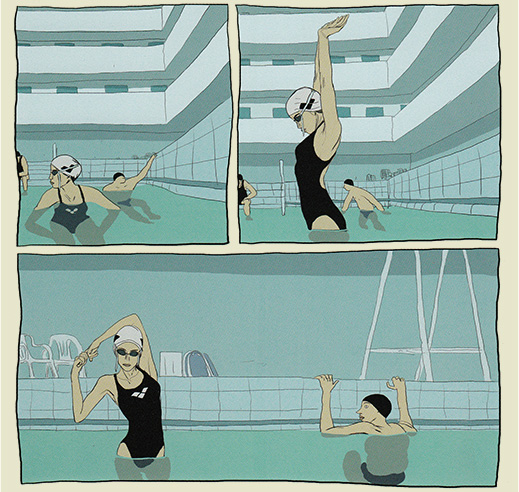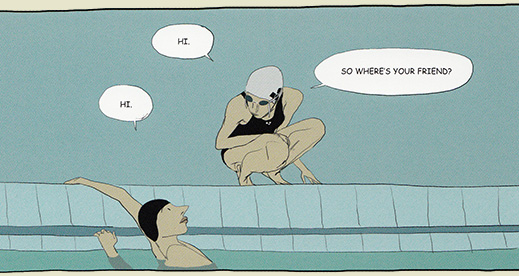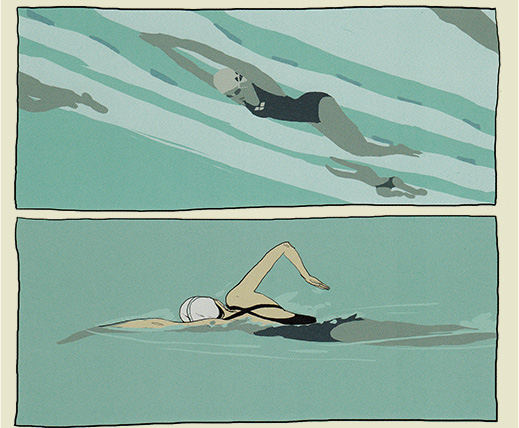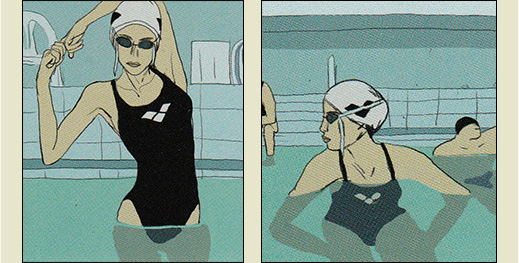A Taste of Chlorine
Language is incredible and language is ridiculous. It is lovely and it is baffling. Language is essential and lively and complicated and lusterant and mystifying and intuitive and impossible. The ability of the human creature to communicate from even the earliest age is astounding. That we, without any specially intended training, acquire the ability to make ourselves known and in turn know others is jaw-dropping. That we, no matter how long we persevere, can never perfectly communicate is agonizing. Language is beguiling. We unlock the front door of its mansion so easily as if born to burglary, intimate friends with the sneaking and the thieving by which all hidden treasures must reveal themselves. But that mansion, which we presume to have the run of, soon unveils itself to have improbable rooms and inescapable mazes. We might even amuse ourselves at the irony that those who train the most diligently in the ins, the outs, and the rules of language are most often the people least capable of making use of the stuff. Language is mystery and, as mystery, language is romance.

As expression and meaning whirl in the confounding dance of interpretation, every aspect of the tableau is made an essentiality. The words spoken. The dialect and tone with which they are produced. The face from which they come. The posture of the body that holds that face. The environment in which the expression is attempted. The body is a medium and the voice a vehicle. Communication seeks passage through these conveyances—only there are so many obstacles, so many threats to obscure intention and tarnish meaning.
A Taste of Chlorine is an evocative treatment of language, of the wonders and woes of the human spirit's attempt to connect to others of the like. Bastien Vivès seems focused on the elusivity of that connection and the concern that even physical proximity can be alienating if language falters. In Taste of Chlorine, art and design and story conspire to sing a kind of methodical lament, a series of mechanical refrains meant to mirror the repetitive nature of the act of swimming while simultaneously signaling an anthem to the soul who struggles with human connection.

And perhaps by ironic accident and perhaps by intention, the reader's experience of the book struggles against this same wall of misapprehension. Vivès climaxes his book with a silent underwater admission, one character to another. The words are mouthed but the character can't quite read lips. And I don't know if Vivès gives his readers the keys to understand or not. I don't know if the words actually can be made out. Because while I am reading an English translation, the woman whose speech is hushed in the weight of water speaks with French lips and presumably with French words. So whether Vivès intends readers to puzzle out the meaning of her lips, I (and most American readers) will be left stumped and frustrated over the inconclusive nature of a moment fraught with importance.
And perhaps that was intentional? But purposed or not, it fits the theme the author glides along. It strikes at how simply we might be distracted from accessing the true meaning of words. A Taste of Chlorine incisively intimates how easy it is for two people to remain foreign to each other—to be shuffled from the path of understanding and hope by little more than a misplaced word and an absence of meaning. This is the story Vivès toys with and his art throughout drives this home.

For a work concerned foremost with communication, Vivès spends surprisingly little time on actual dialogue. He lets his art speak for him and for his characters. The story moves through the stealing of glances, the submergence of physiques, and what is revealed above and below the waterline.
The artist's approach to refraction is (to me) novel and largely unprecedented. He is careful and thoughtful in illustrating the physical properties of water—which is important as nearly the entire work occurs in a public pool. When portraying that which exists below the surface, Vivès abandons his inks entirely and relies on borderless colours and the suggestion of shape to delineate form and feature. The world exaggerates underwater, taking on an alien design.

Engagingly, Vivès avoids any hard rules in his above water inks, giving even the flat, straight substance of walls and floors and benches a kind of warbling dream state, prompting the sense that even the non-pool scenes occur under water. Readers then find themselves in as much discomfort and unease as Vivès' nameless protagonist, never being quite at home enough to trust the reliability of the narrative they encounter. Just as we lack the sea-legs required for comfortable interaction with the text, Vivès' swimmer can never find the words to make himself known or knowable to those with whom he swims.
Language is a tricky bastard of a mistress. Vivès hits all the right notes in his exploration here. He doesn't overwhelm with a regurgitation of theory or pedantry, but his still manages to say plenty. And if you don't quite understand him? If his ultimate meaning sits just beyond reach? Well, that's probably just fine. And maybe even by design.
A note about the art
One of the things about Vivès' art that I loved and wanted to highlight is the way he draws form underwater. Check this out:

This panel is from below the surface. Vivès completely obliterates his inks and relies wholly on his simple colours to tell the story. The swimmer is pushing off the wall in the moment before launching into her next lap. Her legs are coiled in a mess of diminished flesh tones (what Vivès uses for her skin underwater), but Vivès makes certain we know what's going on, implying the position of her left leg by having the ankle appear in the foreground where her crotch would be. Additionally, the lights from the pool's skylight hover above and a man on the edge is partially lit brightly, telling us that his head and shoulders are above the surface.

In these two panels we see how Vivès treats the underwater when the camera is above the surface. Normal inks and colours above, no inks and the less-saturated colours below. Additionally, when the viewer's eye approaches the scene from above the surface, Vivès takes more liberty with the refraction of the body-blobs below. It's a lovely technique.
Good Ok Bad features reviews of comics, graphic novels, manga, et cetera using a rare and auspicious three-star rating system. Point systems are notoriously fiddly, so here it's been pared down to three simple possibilities:
3 Stars = Good
2 Stars = Ok
1 Star = Bad
I am Seth T. Hahne and these are my reviews.
Browse Reviews By
Other Features
- Best Books of the Year:
- Top 50 of 2024
- Top 50 of 2023
- Top 100 of 2020-22
- Top 75 of 2019
- Top 50 of 2018
- Top 75 of 2017
- Top 75 of 2016
- Top 75 of 2015
- Top 75 of 2014
- Top 35 of 2013
- Top 25 of 2012
- Top 10 of 2011
- Popular Sections:
- All-Time Top 500
- All the Boardgames I've Played
- All the Anime Series I've Seen
- All the Animated Films I've Seen
- Top 75 by Female Creators
- Kids Recommendations
- What I Read: A Reading Log
- Other Features:
- Bookclub Study Guides










